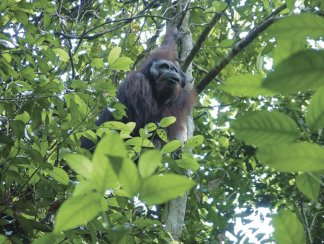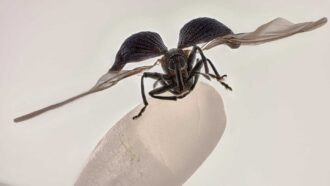Red Apes in Danger
The population of orangutans in northeastern Borneo appears to be falling rapidly.
Share this:
- Share via email (Opens in new window) Email
- Click to share on Facebook (Opens in new window) Facebook
- Click to share on X (Opens in new window) X
- Click to share on Pinterest (Opens in new window) Pinterest
- Click to share on Reddit (Opens in new window) Reddit
- Share to Google Classroom (Opens in new window) Google Classroom
- Click to print (Opens in new window) Print
By Emily Sohn
Orangutans are large, hairy, apes that spend a lot of time alone and high up in trees. They’re fun to watch in zoos because they use their long arms to swing from tree branch to tree branch. In the wild, orangutans are in big trouble.
In recent years, the number of orangutans living in northeastern Borneo has dropped dramatically, according to a new study. Located southeast of mainland Asia, Borneo is the third-largest island in the world. A few decades ago, the northeastern portion of the island was home to more than 20,000 of the red apes. Now, only about 5,000 remain, a team of researchers says.
 |
|
The population of orangutans in northeastern Borneo is falling rapidly. |
| J. Sinyor/KOCP |
The scientists used the genetic material DNA to estimate the number of orangutans. In 2001, they collected orangutan hair and feces from a wildlife sanctuary in Borneo. Both materials contain DNA, and, like a fingerprint, every animal’s DNA is slightly different. The researchers identified about 200 individual apes.
Using computers, the scientists cataloged similarities and differences among these individuals, based on their DNA. Using this information, they then estimated how much the population had changed over time.
The results suggested a 95 percent drop in orangutan populations over the last 100 to 200 years. The most dramatic change occurred in the last few decades.
The study broke new scientific ground. “This is the first time that a recent and alarming decline of a great ape population, brought about by [people], has been demonstrated, dated, and quantified using genetic information,” says geneticist Benoit Goossens of Cardiff University in Wales.
Orangutans are disappearing, the researchers say, mostly because people are destroying the forests the animals live in. Illegal hunting and trading are also taking their toll.
Extinction is now a real possibility. In 2004, a survey suggested that all of the orangutans in Borneo and nearby Sumatra could be gone within 50 years.—E. Sohn
Going Deeper:
Bower, Bruce. 2006. Red alert for red apes: DNA shows big losses for Borneo orangutans. Science News 169(Jan. 28):51. Available at http://www.sciencenews.org/articles/20060128/fob1.asp .
You can learn more about orangutans at www.pbs.org/wnet/nature/orangutans/ (PBS) and www.nationalgeographic.com/kids/creature_feature/
0102/orangutans.html (National Geographic Society).
The Borneo Orangutan Survival Foundation has a Web site at www.orangutans.com.au/ (Borneo Orangutan Survival Foundation).
Information about the island of Borneo can be found at www.pbs.org/edens/borneo/ (PBS).
Sohn, Emily. 2004. An inspiring home for apes. Science News for Kids (July 14). Available at http://www.sciencenewsforkids.org/articles/20040714/Feature1.asp .







